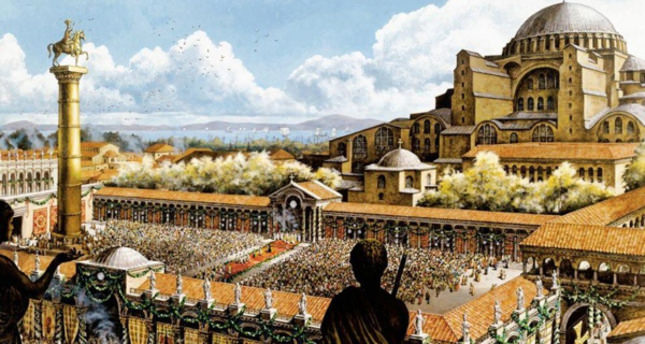
3.1. The Byzantine Empire
Byzantine Empire, the eastern half of the Roman Empire, which survived for a thousand years after the western half had crumbled into various feudal kingdoms and which finally fell to Ottoman Turkish onslaughts in 1453.
The Byzantine Empire, often called the Eastern Roman Empire or simply Byzantium, existed from 330 AD to 1453 AD. With its capital founded at Constantinople by Constantine I (r. 306-337), the Empire varied in size over the centuries, at one time or another, possessing territories located in Italy, Greece, the Balkans, Levant, Asia Minor, and North Africa.
Byzantium was a Christian state with Greek as the official language, the Byzantines developed their own political systems, religious practices, art and architecture, which, although significantly influenced by the Greco-Roman cultural tradition, were distinct and not merely a continuation of ancient Rome. The Byzantine Empire was the longest-lasting medieval power, and its influence continues today, especially in the religion, art, architecture, and law of many Western states, Eastern and Central Europe, and Russia.
It is also called Byzantium, was the eastern half of the Roman Empire that continued on after the western half of the empire collapsed.
Constantinople
The beginnings of the Byzantine Empire lie in the decision of Roman emperor Constantine I to relocate the capital of the Roman Empire from Rome to Byzantium on 11 May AD 330.
The popular name Constantinople or 'City of Constantine' soon replaced the emperor's own official choice of 'New Rome'. The new capital had an excellent natural harbour on the Golden Horn inlet and, straddled on the border between Europe and Asia, could control the passage of ships through the Bosphorus from the Aegean to the Black Sea, linking lucrative trade between west and east.
A great chain stretched across the Golden Horn's entrance, and the construction of the massive Theodosian Walls between 410 AD and 413 AD meant that the city was able to withstand time and again concerted attacks from both sea and land. Over the centuries, as more spectacular buildings were added, the cosmopolitan city became one of the finest of any epoch and certainly the richest, most lavish and most important Christian city in the world.
The Byzantine Empire was based at Constantinople (modern-day Istanbul), and at its peak it controlled territory stretching from southern Spain to Syria.
Byzantine Empire Flourishes
The eastern half of the Roman Empire proved less vulnerable to external attack, thanks in part to its geographic location.
With Constantinople located on a strait, it was extremely difficult to breach the capital’s defenses; in addition, the eastern empire had a much smaller common frontier with Europe.
The very name Byzantine illustrates the misconceptions to which the empire’s history has often been subject, for its inhabitants would hardly have considered the term appropriate to themselves or to their state. Theirs was, in their view, none other than the Roman Empire, founded shortly before the beginning of the Christian era by God’s grace to unify his people in preparation for the coming of his Son.
Proud of that Christian and Roman heritage, convinced that their earthly empire so nearly resembled the heavenly pattern that it could never change, they called themselves Romaioi, or Romans.
Modern historians agree with them only in part. The term East Rome accurately described the political unit embracing the Eastern provinces of the old Roman Empire until 476 AD , while there were yet two emperors. In an effort to recognize that distinction, historians traditionally have described the medieval empire as Byzantine.
https://www.youtube.com/watch?v=Okph9wt8I0A
https://www.youtube.com/watch?v=BNURBs091pk
Murad revoked all privileges given to the Byzantines and laid siege to Constantinople; his successor, Mehmed II, completed this process when he launched the final attack on the city.
On May 29, 1453, after an Ottoman army stormed Constantinople, Mehmed triumphantly entered the Hagia Sophia, which would soon be converted to the city’s leading mosque.
The fall of Constantinople marked the end of a glorious era for the Byzantine Empire. Emperor Constantine XI died in battle that day, and the Byzantine Empire collapsed, ushering in the long reign of the Ottoman Empire.
Throughout their history, the Byzantines rarely controlled Rome and spoke mainly Greek. Despite this, the people of Byzantium continued to refer to themselves as "Romans,
